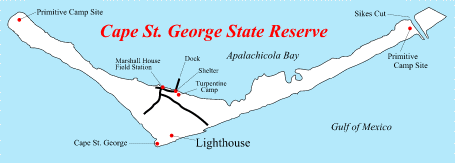This website made possible in part by Crest Enterprises and Land Development, Inc.
©1996-2025, Bluewater iNet Group, LLC
©1996-2025, Bluewater iNet Group, LLC
 |
Cape St. George Cape St. George State Reserve is a pristine section of a 28-mile long barrier island that seperates Apalachicola Bay from the Gulf of Mexico. The 10-mile-long cape, known locally as Little St. George Island, was seperated from the rest of the barrier island by a man-made ship channel in 1954. The cape was purchaced in 1977 under the Environmentally Endangered Lands program to protect it from development and to contribute to the protection of Apalachicola Bay. The reserve's remoteness and wilderness qualities provide an opportunity to explore and enjoy a remnant of Florida's original natural landscape. Natural History Several plant communities occupy the dunes and swales of the cape. Scrub is found on the old relic dune ridges and sea oats occur on the new primary dunes along the beach. Ponds and marshes are found in the low swales between the old dune ridges. Slash pine flatwoods occupy the low, flat areas, and extensive savannahs with scattered cabbage palms are found on overwash portions at the east and west ends of the island. A small coastal hammock, a willow swamp and salt marshes add further diversity. Natural processes in the form of salt spray, hurricanes, erosion and lightning fires have shaped the cape and its plant communities for thousands of years. Natural processes influence virtually all the communities by removing the heavy build-up of fuels, restricting the growth of nonfire-resistant plants and opening the forest by eliminating underbrush. Barrier islands serve as "shock absorbers" which protect the mainland and estuaries from the full force of storm winds and waves. Erosion and the deposition of sand caused by winds and currents constantly change the shape of these islands. In 133 years, the beach at the Cape has moved 400 yards north. There are few mammals on the island due to the distance from the mainland, raccoons are the most common. However, birds are very diverse and abundant during migration in the spring and fall. Most notable are the endangered peregrine falcon and bald eagle. Threatened loggerhead sea turtles nest on the beach during the summer, as do oystercatchers and the endangered snowy plovers. Cottonmouths are common in the ponds and marshes. Cultural History Various Indian cultures occupied St. George Island for hundreds of years prior to the arrival of Europeans. Pottery fragments dating from A.D. 750 to 1450 occasionally are found on older portions of the island. The St. George Lighthouse was built 400 yards from the beach in 1852. After Hurricane Kate in 1985, the lighthouse was on the edge of the beach. It was removed from service by the U.S. Coast Guard in 1994, and collapsed on October 21, 2005. The St. George Lighthouse Association is presently working to restore the historic structure. The island's pine trees were "catfaced" during a turpentining operation from 1910-1916 and again from 1950-56. The old buildings of the turpentine camp are still in existence at the Government Dock. In 1954 the U.S. Army Corps of Engineers constructed the ship channel, Bob Sikes Cut, across St. George Island. This created Little St. George Island and enhanced its remoteness. Man had little lasting influence on the island until the mid-1960s when it was used for an amphibious military training operation. Heavy equipment was used to cut roads and flatten some dune ridges These disturbances will take many years to heal. Management The reserve is managed by the Department of Natural Resources, Division of Recreation and Parks, in cooperation with the Game and Fresh Water Fish Commission. The island plant communities are managed in the original natural condition. Ecological burning is the principle management tool for the pine flatwoods and savannahs. Exotic plants and animals are removed, and man's disturbances are erased, to the extent possible, in order that visitors can see and enjoy "The Real Florida." Protection The reserve is patrolled by rangers to protect the island from wildfires, poaching and other misuse. Vehicles are not permitted. Recreation The reserve is open daily for hiking, primitive camping, nature study, swimming and fishing. Primitive camping is permitted at designated sites at West Pass, Sikes Cut and the government Dock. Access is by private boat only. Pets must be on a six-foot, hand-held leash and well-behaved at all times. For more information, write or phone St. George Island State Park, P.O. Box 62, Eastpoint, FL 32328 Phone: (850) 670-2111 |
||

| Many thanks to another of our fine sponsors:Mentor Gadsden |
